JavaScript is disabled for your browser. Some features of this site may not work without it.
Buscar en RiuNet
Listar
Mi cuenta
Estadísticas
Ayuda RiuNet
Admin. UPV
Aproximación a los paisajes culturales del regadío. La Geria de Lanzarote
Mostrar el registro completo del ítem
Sardà Ferran, J.; Zamora Cabrera, A. (2015). Aproximación a los paisajes culturales del regadío. La Geria de Lanzarote. En Irrigation, Society and Landscape. Tribute to Tom F. Glick. Editorial Universitat Politècnica de València. 845-855. https://doi.org/10.4995/ISL2014.2014.197
Por favor, use este identificador para citar o enlazar este ítem: http://hdl.handle.net/10251/88121
Ficheros en el ítem
Metadatos del ítem
| Título: | Aproximación a los paisajes culturales del regadío. La Geria de Lanzarote | |
| Autor: | Sardà Ferran, Jordi Zamora Cabrera, Antonio | |
| Fecha difusión: |
|
|
| Resumen: |
[EN] La Geria of Lanzarote explains - to our knowledge - the agriculture as a smart way to working
the land. The geometry of "small volcanoes" built by hand, causes the rocks to protect from the perennial
Trade Winds the ...[+]
[ES] La Geria de Lanzarote explica –a nuestro entender– la agricultura como el trabajo inteligente
de la tierra. La geometría de “pequeños volcanes”, construida con las manos, hace que las rocas protejan
de los Alisios ...[+]
|
|
| Palabras clave: |
|
|
| Derechos de uso: | Reconocimiento - No comercial - Sin obra derivada (by-nc-nd) | |
| ISBN: |
|
|
| Fuente: |
|
|
| DOI: |
|
|
| Editorial: |
|
|
| Versión del editor: | http://ocs.editorial.upv.es/index.php/ISL/ISL2014/paper/view/197 | |
| Título del congreso: |
|
|
| Lugar del congreso: |
|
|
| Fecha congreso: |
|
|
| Tipo: |
|








